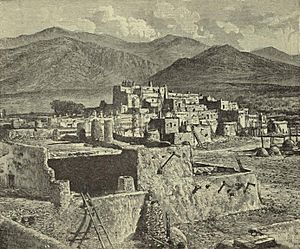Siege of Pueblo de Taos facts for kids
Quick facts for kids Siege of Pueblo de Taos |
|||||||
|---|---|---|---|---|---|---|---|
| Part of the Taos Revolt Mexican–American War |
|||||||
 The death of John Burgwin at the Siege of Taos. |
|||||||
|
|||||||
| Belligerents | |||||||
| Commanders and leaders | |||||||
| Sterling Price John Burgwin † Ceran St. Vrain |
Pablo Chávez Pablo Montoya † Tomás Romero † |
||||||
| Strength | |||||||
| 478 | 600–700 | ||||||
| Casualties and losses | |||||||
| 7–10 killed 45 wounded |
~150 killed | ||||||
The siege of Pueblo de Taos was an important battle. It was the last major fight during the Taos Revolt. This revolt was a rebellion against the United States during the Mexican–American War. It was also the final big battle between American soldiers and rebels in New Mexico during that war.
How the Fight Started
In August 1846, American troops took control of New Mexico. This happened under the command of Stephen Watts Kearny. When Kearny left for California, Colonel Sterling Price took charge of the American forces in New Mexico.
In January 1847, Colonel Price learned about a rebellion. Mexican people in the area were revolting. Price's soldiers fought the rebels at the Battle of Cañada and Battle of Embudo Pass. His forces then moved towards Pueblo de Taos. This place was the center of the rebellion. Another American group fought New Mexicans in Mora. Mora is on the east side of the Sangre de Cristo Mountains.
On February 1, Price's group of 478 men reached the top of Taos Mountain. It was covered in two feet of snow. On February 2, they arrived at Rio Chiquito. This was the entrance to Taos Valley. On February 3, Price marched through Don Fernando de Taos. He then found that the rebels had strongly protected Pueblo de Taos.
The Battle at Taos Pueblo
Colonel Price ordered Lieutenant Dyer to set up cannons. This artillery battery had a 6-pounder cannon and some howitzers. They were placed about 250 yards from the church's western side. They started firing at 2 PM and continued for two and a half hours. Then, they went back to Don Fernando for the night.
Early on February 4, Price set up his troops again. Captain Burgwin's 1st Dragoon Regiment and Major Clarke's light artillery were in the same spot as the cannons the day before. Captain St. Vrain's and Captain Slack's mounted soldiers were placed to stop anyone from escaping. They watched the paths towards the mountains or Don Fernando. The rest of the soldiers were placed 300 yards from the northern wall. Lieutenant Dyer's cannons were also there. This setup meant the front and eastern side of the church were caught in a crossfire.
The cannons began firing at 9 AM. But they could not break through the church walls. So, by 11 AM, Price ordered his soldiers to attack the church. Captain Burgwin and Captain McMillin charged the western side of the church. Captain Agney, Lieutenant Boon, and Captain Barber attacked the northern wall. The church roof was set on fire. Sadly, Captain Burgwin was badly hurt while moving near the front of the church.
A hole was made in the western wall. This allowed soldiers to throw shells inside by hand. The 6-pounder cannon was moved closer. It fired small metal balls into the town. By 3 PM, the 6-pounder was sixty yards from the church. It made the hole bigger after ten shots. Then, it was moved to just ten yards away. It fired three more shots into the church. This allowed Lieutenant Dyer, Lieutenant Wilson, and Taylor to take control of the church. After this, the rebels left the western part of the town.
Rebels trying to escape into the mountains were chased by Captain Slack and Captain St. Vrain. Many were killed before night came. The rebels gave up the next day. They handed over one of their leaders, Tomas Romero, a Pueblo Indian.
What Happened Next
Two of the main rebel leaders, Pablo Montoya and Tomás Romero, were caught during the fighting. Romero died before he could be put on trial. Montoya was found guilty and faced consequences on February 7. Later, other trials led to more people being punished.
After this, there were smaller fights. These included events at the Red River Canyon, Las Vegas, and Taos.
See also
 In Spanish: Sitio del Pueblo de Taos para niños
In Spanish: Sitio del Pueblo de Taos para niños


